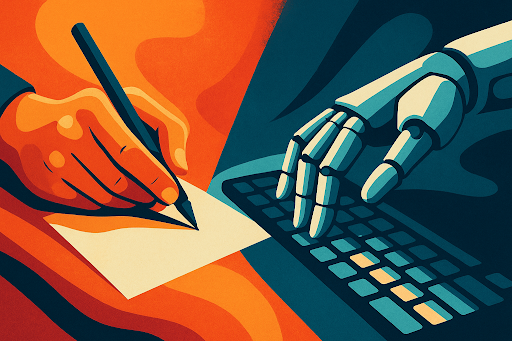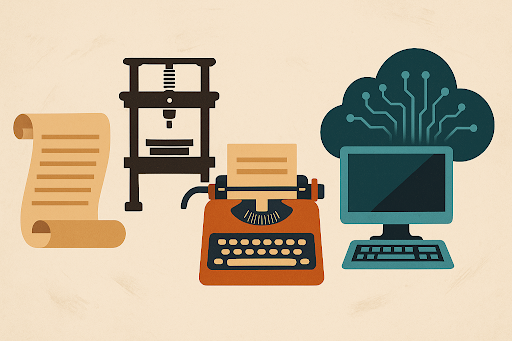
Humanizing AI: The Missing Layer in the AI Revolution

Abstract digital illustration showing a human hand writing on paper while an AI hand types on a keyboard, symbolizing the coexistence of human and machine writing.
AI can write faster than any human has ever written. But speed isn’t the metric that matters.
The real issue is trust, and whether the “real” voice of humans can endure and persist in an age of algorithms.
In this article, we will look at how writing has changed through historical chapters of technology, why trust is the new currency, and how experts, teachers, and humanizer tools are establishing new norms when it comes to generating AI content.
The New Inflection Point
 Illustration depicting the evolution of writing tools, from scrolls and printing presses to typewriters, computers, and AI.
Illustration depicting the evolution of writing tools, from scrolls and printing presses to typewriters, computers, and AI.
Each generation believes it is witnessing the end of writing. The printing press was said to devalue writing by copying it. Typewriters were said to turn writing into a mechanical process. The internet was supposed to drown the world in noise, and therefore writing and essays would become extinct. However, each time a major innovation came along, writing continued to evolve - because fundamentally, writing is more than arranging words together. It is a representation of human thought, experience, and trust.
Artificial intelligence is the most recent example of an evolutionary development in writing technology. While previous innovations have merely sped up or distributed writing, AI can actually generate whole essays, business reports, love letters, even obits. This raises a bigger question than ever before: If machines can imitate our words, do our words still matter?
The answer is yes - but only if we keep emphasizing what machines cannot replicate - authenticity, intent, and the ethical weight of authorship.
Why Trust is the New Currency
 Abstract illustration of a person weighing trust and authenticity against mechanical automation.
Abstract illustration of a person weighing trust and authenticity against mechanical automation.
Credibility is not just a soft metric in business; it’s the backbone of every relationship. A company that uses AI to produce all its content may produce thousands of SEO-laden pieces, but in doing so, it loses the authentic connection that attracts customers. Today’s readers can spot fake language, and increasingly, they reward voices that feel intentional, human, and genuine.
In education, the stakes are just as high. A student who produces an AI-written paper might pass muster a few times, but they’re also depriving themselves of the learning process writing provides: developing critical thinking, intellectual independence, and moral agency. Universities using AI detection tools are not stifling curiosity. They are protecting writing as self-work, a means of figuring things out.
The takeaway applies across contexts: whether a quarterly shareholder letter or a sophomore’s essay on Dunbar’s number, writing that counts must be acknowledged as human labor.
From Efficiency to Integrity
 Illustration of machine-generated documents contrasted with one glowing handwritten page symbolizing authenticity.
Illustration of machine-generated documents contrasted with one glowing handwritten page symbolizing authenticity.
The initial discussions about AI and writing centered solely around speed. Marketers claimed “ten blogs in ten minutes.” Executives wanted content pipelines without bottlenecks. Educators warned of mass plagiarism.
But that discussion is already evolving. Efficiency is meaningless without integrity.
The EY warns about the impending tidal wave of low-quality content. Forbes cautions against “intellectual homogenization,” where originality and creativity are diminished by machine repetition. And The Guardian put it bluntly: “Great stories require people, not AI.”
Not even in technical fields do leaders acknowledge that while AI can accelerate workflows, it cannot deliver credibility. Companies that survive this shift won’t be the ones scaling fastest, but the ones scaling without sacrificing their voice.
Setting Standards in the Boardroom
 Abstract boardroom illustration with humans and AI figures around a glowing document, symbolizing new standards.
Abstract boardroom illustration with humans and AI figures around a glowing document, symbolizing new standards.
AI is transforming corporate communication, but norms are beginning to emerge:
- Transparency: Expectations include disclosure. Hiding the use of AI invites a breach of trust.
- Human-in-the-loop review: AI can expedite drafts, but humans must ultimately review, contextualize, and approve.
- Authenticity guardrails: Tone, nuance, and cultural context cannot be automated. Brands that neglect to protect these elements risk sounding generic.
- Compliance awareness: Regulators in the EU and US are already considering disclosure requirements. Ignoring this could lead to costly shortcuts.
Leaders are recognizing that credibility isn’t just branding—it has tangible consequences for customer loyalty, employee engagement, and investor confidence.
Standards in the Classroom
 Illustration of a classroom split between traditional writing and AI-assisted learning.
Illustration of a classroom split between traditional writing and AI-assisted learning.
The educational debate is even more intense. Should schools ban AI entirely? Or should they welcome it unconditionally? Increasingly, the response is somewhere in between. The road ahead appears to lie within a spectrum.
- AI as scaffolding, not substitution: Students may utilize AI to brainstorm or outline, but they must claim ownership over the final product.
- Detection and dialogue: Rather than simply serving as punishment mechanisms, detection tools should foster conversations surrounding authorship and integrity.
- Sustaining skills: Writing remains essential to critical thinking. Machines cannot replace empathy or moral judgement.
- Equity and access: Schools must ensure that AI does not exacerbate existing inequalities among students based on access to newer tools.
As University of Chicago research highlights, AI could potentially function as a thought partner - a scaffold supporting learning rather than a substitute for it.
Similar to calculators transforming the teaching of mathematics without abolishing it, AI will alter how writing is taught. The problem lies in ensuring that it enhances learning instead of diminishing it.
Creating New Standards: How Humanizer Tools Protect Trust
 A modern abstract digital illustration featuring the logos of WalterWrites, QuillBot, and Grammarly as glowing orbs orbiting in balance, symbolizing innovation, authenticity, and leadership in humanizing AI writing.
A modern abstract digital illustration featuring the logos of WalterWrites, QuillBot, and Grammarly as glowing orbs orbiting in balance, symbolizing innovation, authenticity, and leadership in humanizing AI writing.
Herein lies the value proposition of humanizer tools. Not intended to “fool” detectors or conceal machine-generated content, these leading-edge tools serve as filters that restore natural cadence, nuance, and credibility back to AI-generated drafts. For organizations, they offer protection, guaranteeing that content feels deliberate and not formulaic. For students, they enable rewrites that resemble one’s own voice, reinforcing ownership rather than erasure. And for society as a whole, they remind us that technology exists to support the human voice, not supplant it. For a more detailed breakdown of the industry’s current landscape, see this AI Humanizer Industry Report on Medium.
Leading this new category are tools such as Grammarly, QuillBot, and the WalterWrites AI Humanizer, each working in different ways to ensure AI-generated drafts sound less robotic and more authentically human.
A Future Defined by Standards
 Abstract illustration of humans and AI walking together on a glowing road toward the future.
Abstract illustration of humans and AI walking together on a glowing road toward the future.
AI is not going away, nor should it. Used responsibly, it can accelerate tasks, extend accessibility, and free up more space for deeper creative endeavour. Without human oversight, transparency, and purpose, however, AI threatens to undermine the very trustworthiness that writing relies on.
Future AI-assisted content will not be judged by how fast machines can generate words, but by how well we defend the qualities that make writing human: empathy, judgment, and voice.
Whether in a boardroom or a classroom, the principles remain the same. AI can help us write quickly, but only humans can make writing meaningful and engaging.